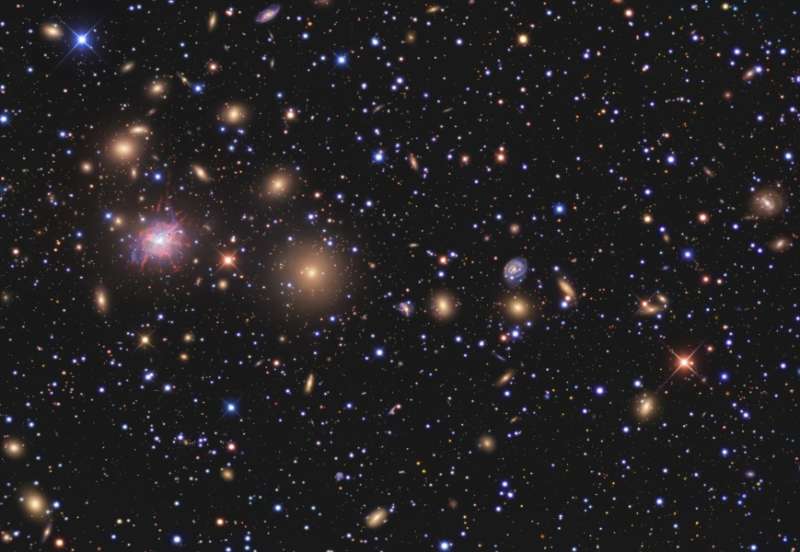Credit & Copyright: R. Jay Gabany
Explanation:
This colorful
telescopic skyscape is filled with galaxies that
lie nearly 250 million light-years away, the galaxies of
the Perseus cluster.
Their extended and sometimes surprising shapes are seen beyond a
veil of foreground stars in our own Milky Way.
Ultimately consisting of over a thousand galaxies,
the
cluster is filled with yellowish
elliptical and
lenticular galaxies,
like those scattered throughout this view of the cluster's
central region.
Notably, at the large galaxy
at the
left is the massive and
bizarre-looking NGC 1275.
A prodigious source of high-energy emission,
active galaxy NGC 1275
dominates the Perseus cluster, accreting matter as entire galaxies
fall into it and feed
the supermassive black hole at the galaxy's core.
Of course, spiral galaxies also inhabit
the Perseus cluster, including the small, face-on spiral
NGC
1268, right of picture center.
The bluish spot on the outskirts of NGC 1268 is supernova SN 2008fg.
At the estimated distance of the Perseus galaxy cluster, this field
spans about 1.5 million light-years.
1999 2000 2001 2002 2003 2004 2005 2006 2007 2008 2009 2010 2011 2012 2013 2014 2015 2016 2017 2018 2019 2020 2021 2022 2023 2024 2025 |
Январь Февраль Март Апрель Май Июнь Июль Август Сентябрь Октябрь Ноябрь Декабрь |
NASA Web Site Statements, Warnings, and Disclaimers
NASA Official: Jay Norris. Specific rights apply.
A service of: LHEA at NASA / GSFC
& Michigan Tech. U.
|
Публикации с ключевыми словами:
NGC 1275 - Perseus cluster - Скопление галактик - скопление персея - активная галактика
Публикации со словами: NGC 1275 - Perseus cluster - Скопление галактик - скопление персея - активная галактика | |
См. также:
Все публикации на ту же тему >> | |
